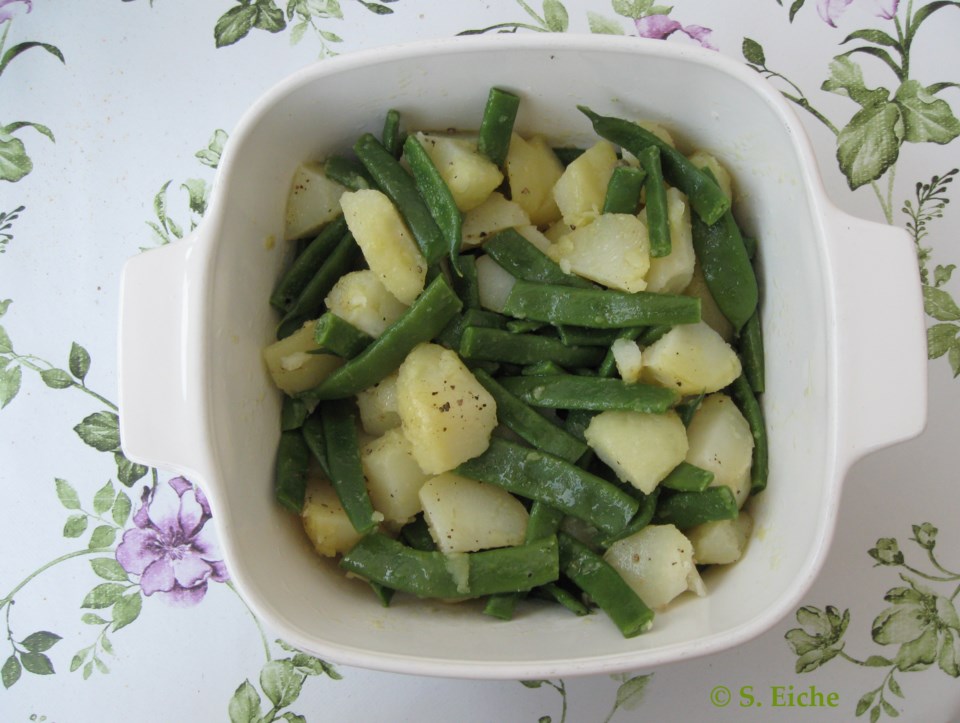Anyone who’s tasted Italian food will agree that it’s something to rave about. Whatever the Italians cook, they use ingredients that are first class, which they combine and prepare in a masterly way. Since we’ve been having one hot day after another this month, I’ve returned to a few of the dishes that sustained me in Florence during the summer.
A classic Tuscan summer dish is the salad known as panzanella. It’s traditionally made with stale bread, tomatoes, cucumber, onions, basil, garlic and capers. In Italy I’d use pane integrale, whole wheat bread, but you can use any bread made with hearty rustic grains, such as spelt or barley. Also, it doesn’t have to be stale as long as it has body.
If using stale bread, soften it by soaking it in water for five to 10 minutes (time depends on the thickness of the bread). When the water is wrung out tear the bread into chunks. Chop the tomatoes and cucumbers and slice the onion. Add everything to the bread. Fresh garlic is perfect for this dish – sliced or chopped. Basil leaves and capers give it a nice punch. Dress with vinegar and olive oil, salt and pepper to taste. Mix well. It’s a good idea to let the panzanella rest for a few hours so the flavours can develop. In my opinion, it tastes even better a day later. Serve at room temperature.
Caponata is a famous Sicilian dish that is served cold (meaning room temperature) as an appetizer, relish, side dish or even main course. I was introduced to caponata not in Sicily but in Florence, at a dinner to which one of the guests contributed her prize-winning caponata. Eva was Neapolitan not Sicilian, but her recipe unquestionably deserved the award. Although there are probably as many versions of caponata as there are households in Sicily, aubergine is the ingredient they all have in common. The other ingredients, sweet as well as savoury, vary according to taste and availability.
Eva’s prize-winning version uses two or three large aubergines, two sweet peppers (Eva preferred green), one large onion, two or three celery stalks, a quarter cup of capers, 100 grams pitted green olives, coarsely chopped, approximately one litre tomato sauce, half a cup of vinegar, a handful of pine nuts, raisins, salt and sugar to taste.
Cut the aubergines into thick slices and cover with coarse salt. After a few hours wash off the salt and drain the aubergine slices, but don’t wring. Cut into cubes and fry in a little olive oil.
Remove the aubergines before they’re fully cooked. Add a little more oil to the pan and stir-fry the peppers, cut into strips. Remove the peppers and stir-fry the chopped onion. Add the aubergines and peppers to the onion in the pan.
Add the tomato sauce, olives, capers, pine nuts, raisins, and – a little at a time, always checking the taste – vinegar, salt and sugar. Cook over low heat for about an hour, stirring occasionally. Add the chopped celery at the very end, and continue cooking for no more than two or three minutes so that the celery remains crunchy. Refrigerate and wait. The longer you wait, the better it tastes.
Potato salad, the perfect summer dish, is a German rather than Italian invention, but with Italian ingredients it becomes even more special. I use waxy potatoes and the green beans that in Italy went by the name of Mangiatutto Supermarconi, because they’re wireless (i.e. stringless). When the potatoes are cooked I cut them into chunks, with or without the peel. While they’re still warm I pour a small amount of diluted vinegar, salt and pepper over them and cover the dish. It takes about 20 or 30 minutes for the potatoes to absorb the liquid. Then I add the Supermarconi beans (regular green beans work just as well) and sometimes also capers and fresh garlic. I pour a little olive oil over the salad and toss gently. A version made by the mother of a friend in southern Italy used more beans than potatoes and added lots of tomatoes and olives.
Dessert in Italy was often fresh fruit. Once I absentmindedly cut up peaches and cucumbers in the same bowl. When I saw what had happened, rather than undoing the mix I added a bit of salt and olive oil. The combination may have been accidental instead of inspired but the taste was divine, and it’s remained a favourite ever since – as both salad and dessert.
Sabine Eiche is a local writer and art historian with a PhD from Princeton University. She is passionately involved in preserving the environment and protecting nature. Her columns deal with a broad range of topics and often include the history (etymology) of words in order to shed extra light on the subject.
Got an opinion on this story or any others in Richmond? Send us a letter or email your thoughts or story tips to [email protected]. To stay updated on Richmond news, sign up for our daily headline newsletter. Words missing in article? Your adblocker might be preventing hyperlinked text from appearing.



